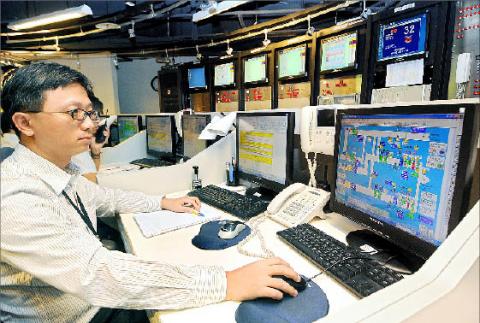Taipei 101 became the tallest building in the world to receive Leadership in Energy and Environmental Design (LEED) Platinum Certification yesterday at an award ceremony in the building’s lobby.
In cooperation with SL+A International, EcoTech International and Siemens Limited Taiwan, staff at Taipei 101 worked for more than 20 months to implement changes that would allow the building to meet the increasingly stringent certification standards.
Developed by the US Green Building Council, LEED is the most widely used green building rating system in the world. Taipei 101 achieved the platinum level certification in the Existing Buildings: Operations and Maintenance category.

Photo: Fang Pin-chao, Taipei Times
With a total floor space of 357,721m2, 90 tenants and a day-time population of more than 10,000 people, the project posed a number of challenges to implement, not to mention the NT$60 million (US$2.08 million) price-tag.
However, it was well worth it, Taipei 101 officials said.
“We started improving energy efficiency in 2007 and in the three years to 2010, we have already made that money back. From now on, we expect to save NT$36 million or US$1.2 million each year on energy costs, compared to 2007 levels” said Cathy Yang (楊文琪), vice president of the tower division of Taipei 101.
As for the wider impact of the project, green building experts said the assumption was that only newly constructed buildings could meet LEED standards, but Taipei 101’s certification could be the “lighthouse” project leading the way for other existing buildings to follow suit.
“When a world celebrity building like [Taipei] 101 achieves the highest level of certification, you know that every tall building on the planet as well as every little building on the planet is going to be looking somehow to emulate the achievement,” Rob Watson, chairman, CEO and chief scientist of EcoTech International and the “father of the LEED” certification, said yesterday.
Mark MacCracken, chairman of the US Green Building Council, said the achievement by Taipei 101 at the platinum level has taken away the excuses from other buildings around the world for not being able to do so.
“[People would say] ‘oh, we can’t do that. We’re too tall, we’re too this, we have too many tenants,’ this sort of thing — that discussion is now off the table because of this building and I think that that’s the biggest statement this building has made for the industry,” MacCracken said.

Shares in Taiwan closed at a new high yesterday, the first trading day of the new year, as contract chipmaker Taiwan Semiconductor Manufacturing Co (TSMC, 台積電) continued to break records amid an artificial intelligence (AI) boom, dealers said. The TAIEX closed up 386.21 points, or 1.33 percent, at 29,349.81, with turnover totaling NT$648.844 billion (US$20.65 billion). “Judging from a stronger Taiwan dollar against the US dollar, I think foreign institutional investors returned from the holidays and brought funds into the local market,” Concord Securities Co (康和證券) analyst Kerry Huang (黃志祺) said. “Foreign investors just rebuilt their positions with TSMC as their top target,

H200 CHIPS: A source said that Nvidia has asked the Taiwanese company to begin production of additional chips and work is expected to start in the second quarter Nvidia Corp is scrambling to meet demand for its H200 artificial intelligence (AI) chips from Chinese technology companies and has approached contract manufacturer Taiwan Semiconductor Manufacturing Co (TSMC, 台積電) to ramp up production, sources said. Chinese technology companies have placed orders for more than 2 million H200 chips for this year, while Nvidia holds just 700,000 units in stock, two of the people said. The exact additional volume Nvidia intends to order from TSMC remains unclear, they said. A third source said that Nvidia has asked TSMC to begin production of the additional chips and work is expected to start in the second

REVENUE PERFORMANCE: Cloud and network products, and electronic components saw strong increases, while smart consumer electronics and computing products fell Hon Hai Precision Industry Co (鴻海精密) yesterday posted 26.51 percent quarterly growth in revenue for last quarter to NT$2.6 trillion (US$82.44 billion), the strongest on record for the period and above expectations, but the company forecast a slight revenue dip this quarter due to seasonal factors. On an annual basis, revenue last quarter grew 22.07 percent, the company said. Analysts on average estimated about NT$2.4 trillion increase. Hon Hai, which assembles servers for Nvidia Corp and iPhones for Apple Inc, is expanding its capacity in the US, adding artificial intelligence (AI) server production in Wisconsin and Texas, where it operates established campuses. This

Garment maker Makalot Industrial Co (聚陽) yesterday reported lower-than-expected fourth-quarter revenue of NT$7.93 billion (US$251.44 million), down 9.48 percent from NT$8.76 billion a year earlier. On a quarterly basis, revenue fell 10.83 percent from NT$8.89 billion, company data showed. The figure was also lower than market expectations of NT$8.05 billion, according to data compiled by Yuanta Securities Investment and Consulting Co (元大投顧), which had projected NT$8.22 billion. Makalot’s revenue this quarter would likely increase by a mid-teens percentage as the industry is entering its high season, Yuanta said. Overall, Makalot’s revenue last year totaled NT$34.43 billion, down 3.08 percent from its record NT$35.52